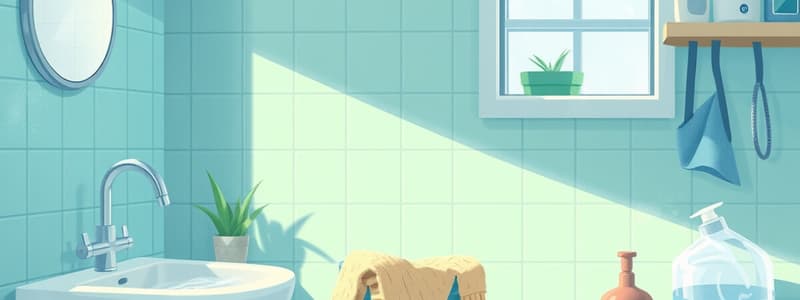Podcast
Questions and Answers
What is cleaning?
What is cleaning?
Removes food and other dirt from a surface.
What does sanitizing do?
What does sanitizing do?
Reduces pathogens on a surface to safe levels.
What characteristics must cleaners have?
What characteristics must cleaners have?
- Safe to use (correct)
- Corrosive
- Noncorrosive (correct)
- Stable (correct)
Which of the following are types of cleaners? (Select all that apply)
Which of the following are types of cleaners? (Select all that apply)
Cleaners can be used interchangeably.
Cleaners can be used interchangeably.
Food contact surfaces must be sanitized after they have been cleaned.
Food contact surfaces must be sanitized after they have been cleaned.
What is heat sanitizing?
What is heat sanitizing?
What are common types of chemical sanitizers? (Select all that apply)
What are common types of chemical sanitizers? (Select all that apply)
What factors influence the effectiveness of chemical sanitizers?
What factors influence the effectiveness of chemical sanitizers?
How is sanitizer concentration measured?
How is sanitizer concentration measured?
What affects the sanitizer’s effectiveness?
What affects the sanitizer’s effectiveness?
What is contact time?
What is contact time?
What is water hardness?
What is water hardness?
What does pH affect?
What does pH affect?
What temperatures are required for chlorine sanitizing?
What temperatures are required for chlorine sanitizing?
When must surfaces that touch food be sanitized?
When must surfaces that touch food be sanitized?
What are the steps for cleaning and sanitizing surfaces? (Select all that apply)
What are the steps for cleaning and sanitizing surfaces? (Select all that apply)
When should you clean and sanitize equipment?
When should you clean and sanitize equipment?
Flashcards are hidden until you start studying
Study Notes
Cleaning and Sanitizing Overview
- Cleaning involves removing food and dirt from surfaces.
- Sanitizing reduces pathogens on surfaces to safe levels.
Types of Cleaners
- Must be stable, noncorrosive, and safe.
- Categories include detergents, degreasers, delimers, and abrasive cleaners.
Cleaner Guidelines
- Follow manufacturer instructions precisely for safety and effectiveness.
- Use cleaners only for their intended purposes; avoid substituting different types.
Sanitizers
- Must sanitize food contact surfaces after cleaning and rinsing.
- Sanitizing can be done using heat or chemical methods.
Heat Sanitizing
- Soaking in water at 171°F for 30 seconds is one method.
- High-temperature dishwashers can also be used for sanitizing.
Chemical Sanitizing
- Includes soaking or spraying tableware and utensils in a sanitizer solution.
- Common chemical sanitizers include chlorine, iodine, and quaternary ammonium compounds (quats).
- Regulated by state and federal environmental protection agencies.
Factors Influencing Sanitizer Effectiveness
- Key factors: concentration, temperature, contact time, water hardness, and pH.
Concentration
- A mix of chemical sanitizer and water is critical; measured in parts per million (ppm).
- Testing kits are used to check concentration.
- Hard water and contaminants can reduce sanitizer effectiveness.
Temperature
- Sanitizing solutions must maintain proper water temperature for effectiveness.
Contact Time
- Defined as the time a disinfectant requires for the desired microbial effect, per the manufacturer's instructions.
Water Hardness
- Refers to the mineral content in water, which can impact sanitizer effectiveness.
pH
- The acidity or basicity of a solution can influence sanitizer efficiency.
Chlorine Specifics
- Water temperature for effective chlorine sanitation must exceed 100°F (38°C).
- Maintain chlorine solutions within specified pH levels for optimal performance.
When to Clean and Sanitize
- Surfaces that touch food must be cleaned, sanitized, and rinsed to prevent dirt accumulation.
- Important times include after use, before switching food types, after interruptions, and after four hours of continuous use.
Cleaning and Sanitizing Surfaces: Guidelines
- Start by removing food from the surface.
- Wash with an approved cleaner followed by rinsing.
- Sanitize with a properly prepared sanitizing solution.
- Allow surfaces to air dry.
Cleaning and Sanitizing Equipment
- Unplug equipment before cleaning.
- Remove and clean removable parts by hand or in a dishwasher if permissible.
- Wash, rinse, and sanitize all surfaces to ensure thorough cleanliness.
- Ensure air drying to avoid contamination.
Studying That Suits You
Use AI to generate personalized quizzes and flashcards to suit your learning preferences.



